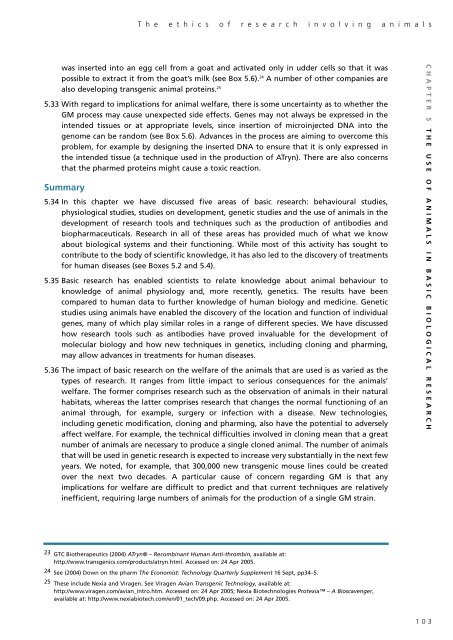The ethics of research involving animals - Nuffield Council on ...
The ethics of research involving animals - Nuffield Council on ...
The ethics of research involving animals - Nuffield Council on ...
Create successful ePaper yourself
Turn your PDF publications into a flip-book with our unique Google optimized e-Paper software.
T h e e t h i c s o f r e s e a r c h i n v o l v i n g a n i m a l s<br />
was inserted into an egg cell from a goat and activated <strong>on</strong>ly in udder cells so that it was<br />
possible to extract it from the goat’s milk (see Box 5.6). 24 A number <str<strong>on</strong>g>of</str<strong>on</strong>g> other companies are<br />
also developing transgenic animal proteins. 25<br />
5.33 With regard to implicati<strong>on</strong>s for animal welfare, there is some uncertainty as to whether the<br />
GM process may cause unexpected side effects. Genes may not always be expressed in the<br />
intended tissues or at appropriate levels, since inserti<strong>on</strong> <str<strong>on</strong>g>of</str<strong>on</strong>g> microinjected DNA into the<br />
genome can be random (see Box 5.6). Advances in the process are aiming to overcome this<br />
problem, for example by designing the inserted DNA to ensure that it is <strong>on</strong>ly expressed in<br />
the intended tissue (a technique used in the producti<strong>on</strong> <str<strong>on</strong>g>of</str<strong>on</strong>g> ATryn). <str<strong>on</strong>g>The</str<strong>on</strong>g>re are also c<strong>on</strong>cerns<br />
that the pharmed proteins might cause a toxic reacti<strong>on</strong>.<br />
Summary<br />
5.34 In this chapter we have discussed five areas <str<strong>on</strong>g>of</str<strong>on</strong>g> basic <str<strong>on</strong>g>research</str<strong>on</strong>g>: behavioural studies,<br />
physiological studies, studies <strong>on</strong> development, genetic studies and the use <str<strong>on</strong>g>of</str<strong>on</strong>g> <str<strong>on</strong>g>animals</str<strong>on</strong>g> in the<br />
development <str<strong>on</strong>g>of</str<strong>on</strong>g> <str<strong>on</strong>g>research</str<strong>on</strong>g> tools and techniques such as the producti<strong>on</strong> <str<strong>on</strong>g>of</str<strong>on</strong>g> antibodies and<br />
biopharmaceuticals. Research in all <str<strong>on</strong>g>of</str<strong>on</strong>g> these areas has provided much <str<strong>on</strong>g>of</str<strong>on</strong>g> what we know<br />
about biological systems and their functi<strong>on</strong>ing. While most <str<strong>on</strong>g>of</str<strong>on</strong>g> this activity has sought to<br />
c<strong>on</strong>tribute to the body <str<strong>on</strong>g>of</str<strong>on</strong>g> scientific knowledge, it has also led to the discovery <str<strong>on</strong>g>of</str<strong>on</strong>g> treatments<br />
for human diseases (see Boxes 5.2 and 5.4).<br />
5.35 Basic <str<strong>on</strong>g>research</str<strong>on</strong>g> has enabled scientists to relate knowledge about animal behaviour to<br />
knowledge <str<strong>on</strong>g>of</str<strong>on</strong>g> animal physiology and, more recently, genetics. <str<strong>on</strong>g>The</str<strong>on</strong>g> results have been<br />
compared to human data to further knowledge <str<strong>on</strong>g>of</str<strong>on</strong>g> human biology and medicine. Genetic<br />
studies using <str<strong>on</strong>g>animals</str<strong>on</strong>g> have enabled the discovery <str<strong>on</strong>g>of</str<strong>on</strong>g> the locati<strong>on</strong> and functi<strong>on</strong> <str<strong>on</strong>g>of</str<strong>on</strong>g> individual<br />
genes, many <str<strong>on</strong>g>of</str<strong>on</strong>g> which play similar roles in a range <str<strong>on</strong>g>of</str<strong>on</strong>g> different species. We have discussed<br />
how <str<strong>on</strong>g>research</str<strong>on</strong>g> tools such as antibodies have proved invaluable for the development <str<strong>on</strong>g>of</str<strong>on</strong>g><br />
molecular biology and how new techniques in genetics, including cl<strong>on</strong>ing and pharming,<br />
may allow advances in treatments for human diseases.<br />
5.36 <str<strong>on</strong>g>The</str<strong>on</strong>g> impact <str<strong>on</strong>g>of</str<strong>on</strong>g> basic <str<strong>on</strong>g>research</str<strong>on</strong>g> <strong>on</strong> the welfare <str<strong>on</strong>g>of</str<strong>on</strong>g> the <str<strong>on</strong>g>animals</str<strong>on</strong>g> that are used is as varied as the<br />
types <str<strong>on</strong>g>of</str<strong>on</strong>g> <str<strong>on</strong>g>research</str<strong>on</strong>g>. It ranges from little impact to serious c<strong>on</strong>sequences for the <str<strong>on</strong>g>animals</str<strong>on</strong>g>’<br />
welfare. <str<strong>on</strong>g>The</str<strong>on</strong>g> former comprises <str<strong>on</strong>g>research</str<strong>on</strong>g> such as the observati<strong>on</strong> <str<strong>on</strong>g>of</str<strong>on</strong>g> <str<strong>on</strong>g>animals</str<strong>on</strong>g> in their natural<br />
habitats, whereas the latter comprises <str<strong>on</strong>g>research</str<strong>on</strong>g> that changes the normal functi<strong>on</strong>ing <str<strong>on</strong>g>of</str<strong>on</strong>g> an<br />
animal through, for example, surgery or infecti<strong>on</strong> with a disease. New technologies,<br />
including genetic modificati<strong>on</strong>, cl<strong>on</strong>ing and pharming, also have the potential to adversely<br />
affect welfare. For example, the technical difficulties involved in cl<strong>on</strong>ing mean that a great<br />
number <str<strong>on</strong>g>of</str<strong>on</strong>g> <str<strong>on</strong>g>animals</str<strong>on</strong>g> are necessary to produce a single cl<strong>on</strong>ed animal. <str<strong>on</strong>g>The</str<strong>on</strong>g> number <str<strong>on</strong>g>of</str<strong>on</strong>g> <str<strong>on</strong>g>animals</str<strong>on</strong>g><br />
that will be used in genetic <str<strong>on</strong>g>research</str<strong>on</strong>g> is expected to increase very substantially in the next few<br />
years. We noted, for example, that 300,000 new transgenic mouse lines could be created<br />
over the next two decades. A particular cause <str<strong>on</strong>g>of</str<strong>on</strong>g> c<strong>on</strong>cern regarding GM is that any<br />
implicati<strong>on</strong>s for welfare are difficult to predict and that current techniques are relatively<br />
inefficient, requiring large numbers <str<strong>on</strong>g>of</str<strong>on</strong>g> <str<strong>on</strong>g>animals</str<strong>on</strong>g> for the producti<strong>on</strong> <str<strong>on</strong>g>of</str<strong>on</strong>g> a single GM strain.<br />
CHAPTER 5 THE USE OF ANIMALS IN BASIC BIOLOGICAL RESEARCH<br />
23 GTC Biotherapeutics (2004) ATryn® – Recombinant Human Anti-thrombin, available at:<br />
http://www.transgenics.com/products/atryn.html. Accessed <strong>on</strong>: 24 Apr 2005.<br />
24 See (2004) Down <strong>on</strong> the pharm <str<strong>on</strong>g>The</str<strong>on</strong>g> Ec<strong>on</strong>omist: Technology Quarterly Supplement 16 Sept, pp34–5.<br />
25 <str<strong>on</strong>g>The</str<strong>on</strong>g>se include Nexia and Viragen. See Viragen Avian Transgenic Technology, available at:<br />
http://www.viragen.com/avian_intro.htm. Accessed <strong>on</strong>: 24 Apr 2005; Nexia Biotechnologies Protexia – A Bioscavenger,<br />
available at: http://www.nexiabiotech.com/en/01_tech/09.php. Accessed <strong>on</strong>: 24 Apr 2005.<br />
103
















